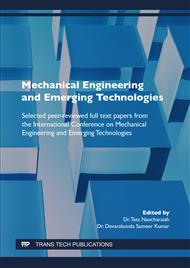[1]
D.F. Adams, Engineering composite materials, Composites. 18 (1987) 261.
Google Scholar
[2]
D.B. Miracle, Metal matrix composites – From science to technological significance, Compos. Sci. Technol. 65 (2005) 2526–2540.
DOI: 10.1016/j.compscitech.2005.05.027
Google Scholar
[3]
P.K. Rohatgi, Metal-matrix Composites, Def. Sci. J. 43 (1993) 323–349.
Google Scholar
[4]
M.K. Surappa, Aluminium matrix composites : Challenges and opportunities, Sadhana. 28 (2003) 319–334.
DOI: 10.1007/bf02717141
Google Scholar
[5]
R. Govindarao, R.I. Ganguly, R.R. Dash, P. Surya Prakash Rao, G.S. Reddy, S.K. Singh, Development of a Novel Aluminium Based Metal Matrix Composite using Insitu Ternary Mixture ( Al2O3 -SiC-C ) Prepared by Thermal Treatment of Fly-ash, Trans. Indian Inst. Met. 68 (2015) 951–958.
DOI: 10.1007/s12666-015-0532-x
Google Scholar
[6]
P.K. Rohatgi, A. Daoud, B.F. Schultz, T. Puri, Microstructure and mechanical behavior of die casting AZ91D-Fly ash cenosphere composites, Compos. Part A. 40 (2009) 883–896.
DOI: 10.1016/j.compositesa.2009.04.014
Google Scholar
[7]
S.S. Raju, G.S. Rao, B.V. Siva, Experimental studies of mechanical properties and tribological behaviour of aluminium composite reinforced with coconut shell ash particulates, Int. J. Mater. Eng. Innov. 9 (2018) 140–157.
DOI: 10.1504/ijmatei.2018.093812
Google Scholar
[8]
R. Siva Sankara Raju, M.K. Panigrahi, R.I. Ganguly, G. Srinivasa Rao, Investigation of tribological performance of hybrid aluminium metal matrix composite, in: I. Nilanjan senpupta (Ed.), 31st Indian Eng. Congr., Technical, Allied publishers pvt. Ltd, Kolkata, 2016: p.241–245.
Google Scholar
[9]
R. Siva Sankar Raju, G. Srinivasa Rao, M. Muralidhara rao, Optimization of Machinability Properties on Aluminium Metal Matrix Composite Prepared By In- Situ Ceramic Mixture Using Coconut Shell Ash - Taguchi Approach, Int. J. Conceptions Mech. Civ. Eng. 3 (2015) 17–21.
Google Scholar
[10]
T.P. Murali, M.K. Surappa, P.K. Rohatgi, Preparation and properties of Al-alloy coconut shell char particulate composites, Metall. Trans. B. 13 (1982) 485–494.
DOI: 10.1007/bf02667765
Google Scholar
[11]
Siva Sankara Raju, G. Srinivasa Rao, C. Samantra, Wear behavioral assessment of Al-CSAp-MMCs using grey-fuzzy approach, Measurement. 140 (2019) 254–268.
DOI: 10.1016/j.measurement.2019.04.004
Google Scholar
[12]
P.K. Rohatgi, R.Q. Guo, P. Huang, S. Ray, Friction and Abrasion Resistance of Cast Aluminum Alloy – Fly Ash Composites, Metall. Mater. Trans. A. 28A (1997) 245–250.
DOI: 10.1007/s11661-997-0102-x
Google Scholar
[13]
S.B.V. Siva, K.L. Sahoo, R.I. Ganguly, R.R. Dash, Effect of Hot Working on Structure and Tribological Properties of Aluminium Reinforced with Aluminium Oxide Particulates, J. Mater. Eng. Perform. 21 (2012) 1226–1231.
DOI: 10.1007/s11665-011-0027-9
Google Scholar
[14]
K.S. Alhawari, M.Z. Omar, M.J. Ghazali, M.S. Salleh, M.N. Mohammed, Evaluation of the microstructure and dry sliding wear behaviour of thixoformed A319 aluminium alloy, Mater. Des. 76 (2015) 169–180.
DOI: 10.1016/j.matdes.2015.03.057
Google Scholar
[15]
V. Singh, D. Joung, L. Zhai, S. Das, Progress in Materials Science Graphene based materials : Past , present and future, Prog. Mater. Sci. 56 (2011) 1178–1271.
DOI: 10.1016/j.pmatsci.2011.03.003
Google Scholar
[16]
T.R. Prabhu, Modelling studies on effects of deformation speed, preform shape, and upset ratio on the forging characteristics of the aerospace structural Al alloys, Int. J. Mater. Prod. Technol. 54 (2017) 291.
DOI: 10.1504/ijmpt.2017.10003618
Google Scholar


